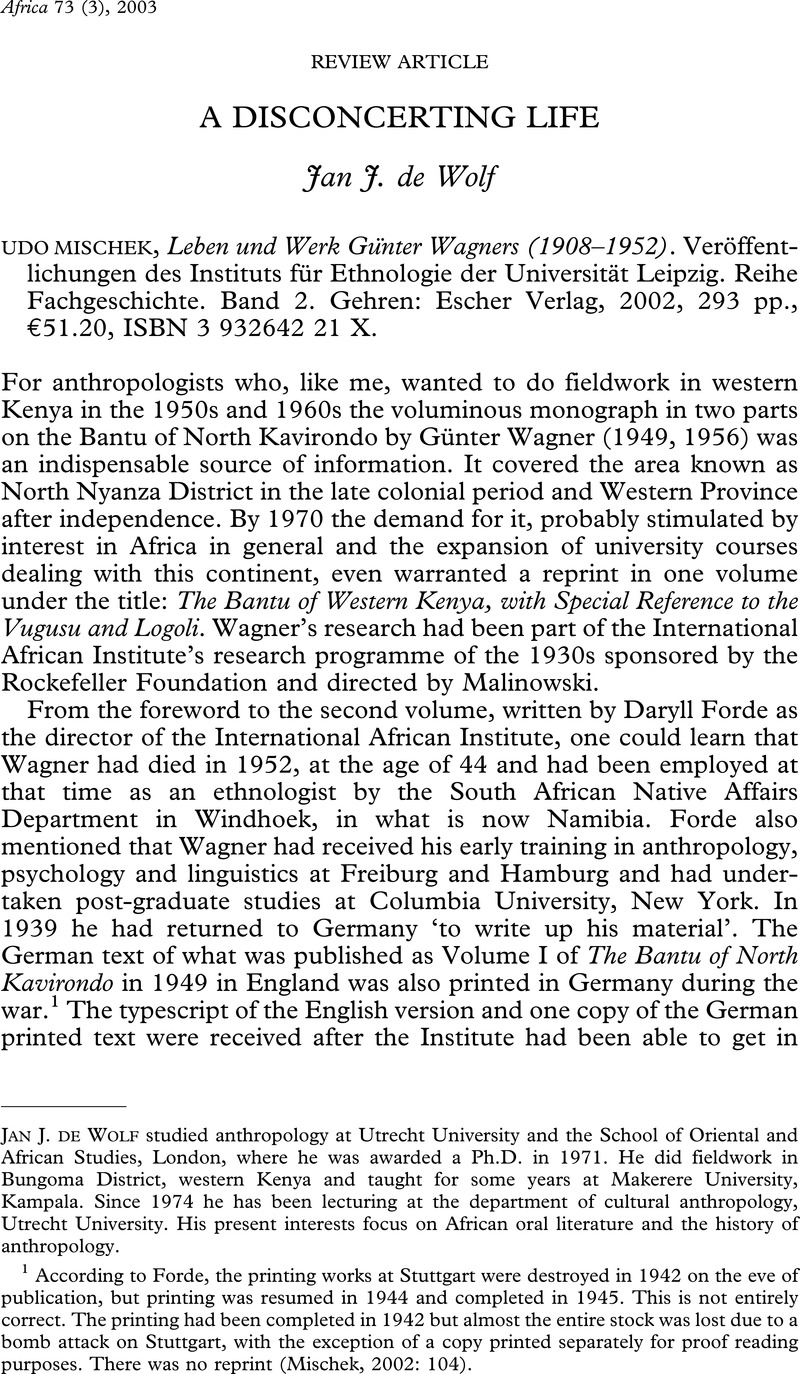No CrossRef data available.
Article contents
Abstract
An abstract is not available for this content so a preview has been provided. Please use the Get access link above for information on how to access this content.

- Type
- Review Article
- Information
- Copyright
- Copyright © International African Institute 2003
References
REFERENCES
Boas, F. 1932. Rasse und Kultur, Rede anlässlich der goldenen Promotion, gehalten am 30. Juli 1931 an der Christian-Albrechts-Universität, Jena. Jena.Google Scholar
Bode, F. G. 1978. ‘Leadership and politics among the Abaluyia of Kenya, 1894–1963’. Unpublished doctoral dissertation, Yale University.Google Scholar
de Wolf, J. J. 1977. Differentiation and Integration in Western Kenya: a study of religious innovation and social change among the Bukusu. The Hague: Mouton.CrossRefGoogle Scholar
de Wolf, J. J. (ed.). 1995. Bukusu Tales: collected around 1936 by research assistants of Dr. Günter Wagner (1908–1952). Münster: LIT Verlag.Google Scholar
Fausto, C. and Neiburg, F. 2002. ‘An interview with Adam Kuper’, Current Anthropology 43 (2), 305–12.CrossRefGoogle Scholar
Fischer, H. 1990. Völkerkunde im Nationalsozialismus. Aspekte der Anpassung, Affinität und Behauptung einer wissenschaftlichen Disziplin. Berlin/Hamburg: Dietrich Reimer Verlag.Google Scholar
Fore, D. 1956. ‘Foreword’, in Wagner, G., The Bantu of North Kavirondo. Volume II. Economic Life, pp. v–vi. London etc.: Oxford University Press, for the International African Institute.Google Scholar
Gilpin, C. W. 1976. ‘The Church and the Community: Quakers in western Kenya, 1902–1963’. Ph.D. thesis, Columbia University. Ann Arbor MI: University Microfilms International.Google Scholar
Malinowski, B. 1938. ‘Introductory essay on the anthropology of changing African cultures’, in Malinowski, B. (ed.), Methods of Study of Culture Contact in Africa, Memorandum XV, pp. vii–xxxviii. London: International Institute of African Languages and Cultures.Google Scholar
Wagner, G. 1931. Yuchi Taies. Publications of the American Ethnological Society, v 13. New York: G. E. Steche, agents. Reprinted 1974 New York: AMS Press.Google Scholar
Wagner, G. 1932. ‘Entwicklung und Verbreitung des Peyotes-Kultes’, Baessler-Archiv 15–17: 59–144.Google Scholar
Wagner, G. 1934. ‘Yuchi Grammar’, in Boas, F.(ed.), Handbook of American Indian Languages. Part 3, pp. 295–384. New York: Columbia University Press.Google Scholar
Wagner, G. 1937. ‘Witchcraft among the Azande. A review of Dr. Evans-Pritchard's book’, Journal of the Royal African Society 37, 469–76.Google Scholar
Wagner, G. 1938. ‘Native institutions and local government’, in Oxford Summer School for Colonial Adminstration, pp. 80–83. Oxford.Google Scholar
Wagner, G. 1939a. ‘Reifeweihen bei den Bantustõmmen Kavirondos und ihre heutige Bedeutung’, Archiv für Anthropologie, Völkerforsciung und Kulturwandel, Neue Folge 25, 85–100.Google Scholar
Wagner, G. 1939b. ‘Die traditionelle und die moderne Familie bei den Bantu-Kavirondo’, Archiv für Anthropologie, Völkerforsciung und Kulturwandel, Neue Folge 25, 1–36.Google Scholar
Wagner, G. 1939c. ‘The Changing Family among the Bantu Kavirondo’, Africa 12, supplement.Google Scholar
Wagner, G. 1940a. ‘The political organization of the Bantu of Kavirondo’, in Fortes, M. and Evans-Pritchard, E. E. (eds), African Political Systems, pp. 196–236. London: Oxford University Press, for the International African Institute.Google Scholar
Wagner, G. 1940b. ‘Völkerkunde und Eingeborenenlenkung’, Koloniale Rundschau 30, 253–67.Google Scholar
Wagner, G. 1942. ‘Das quantitative Verfahren in der völkerkundlichen Feldforschung’, Beiträge zur Kolonialforschung 1, 111–28.Google Scholar
Wagner, G. 1949. The Bantu of North Kavirondo. Volume I. London: Oxford University Press, for the International African Institute. Reprinted with Volume II in one volume, 1970. The Bantu of Western Kenya: with special reference to the Vugusu and Logoli. London: Oxford University Press, for the International African Institute.Google Scholar
Wagner, G. 1952. ‘Aspects of conservatism and adaptation in the economic life of the Herero’, Sociologus 2, 1–25.Google Scholar
Wagner, G. 1954. ‘Some economic aspects of Herero life’, African Studies 13 (3–4), 117–39.CrossRefGoogle Scholar
Wagner, G. 1956. The Bantu of North Kavirondo. Volume II. Economic Life. London: Oxford University Press, for the International African Institute. Reprinted with Volume I in one volume, 1970. The Bantu of Western Kenya: with special reference to the Vugusu and Logoli. London: Oxford University Press, for the International African Institute.Google Scholar
Wagner, G. 1957. A study of Okahandja district (South West Africa). Revised and edited by Köhler, O.. Ethnological publications no. 38. Pretoria: Department of Native Affairs.Google Scholar




